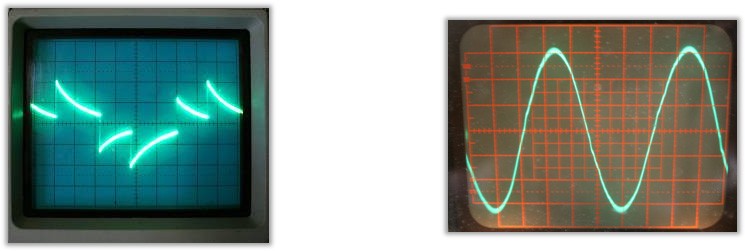Modified sine wave inverters are a cost-effective choice to run appliances and equipment that is less sensitive to power fluctuations, such as lights and some tools. Modified sine wave inverters simulate AC power inverted from DC batteries.
INVERTER
The primary job of an inverter is to convert the DC (Direct Current) power from the battery bank or solar panels to AC (Alternating Current) power needed for most appliances. To do that, it must take the constant DC voltage and change it to a sine wave curve that goes above and below 0 volts. When inverters first came out, the most common way to do this was to make the voltage go straight up and down, creating a blocky signal. This is called modified sine wave, seen in orange in the image below. More advanced modified sine waves make multiple steps, trying to come close to a pure sine wave.
In the following images, you can see an output of a modified sine wave on an oscilloscope at the left. A Pure Sine wave is shown on the right. Other than how the signal looks, what’s the difference between the two outputs?
A modified sine wave inverter can be used for simple systems that don’t have any delicate electronics or audio equipment that may pick up the choppy wave and produce a hum. Old tube TVs and motors with brushes are usually ok with modified sine wave. Your digital clock will likely act funky, and battery rechargers quite often just plain won’t work. Some equipment may seem to be working fine, but may run hotter than with a pure sine wave and reduce the life of it.
Take heed if you’re considering buying a modified square wave inverter to shave a few bucks off your system costs. A whole raft of modern appliances won’t run as well and some not at all on this waveform:
- Laser printers, photocopiers, and anything with an electrical component called a thyristor
- Anything with a silicon-controlled rectifier (SCR), like those used in some washing machine controls
- A few laptop computers
- Some fluorescent lights with electronic ballasts
- Some battery chargers for cordless tools
- Some new furnaces and pellet heaters with microprocessor controls
- Digital clocks with radios
- Appliances having speed/microprocessor controls (like some sewing machines)
- X-10 home automation systems
- Medical equipment such as oxygen concentrators
In general, because the total harmonic distortion is higher in modified square wave inverters, motors will run hotter (less efficiently, consuming up to 30% more energy than with pure sine wave inverters), and likely not last as long. Additionally, a modified square wave inverter will often cause a “buzz” to be heard from audio devices and sometimes other appliances like ceiling fans and microwave ovens.
We liken using a modified sine wave inverter to running a car with square wheels versus a pure sine wave inverter like running a car with round wheels. In the first case the ride is going to be awful rough and depending on the sensitivity of


